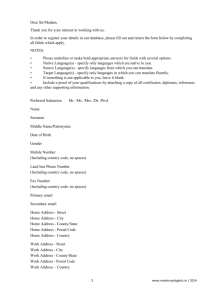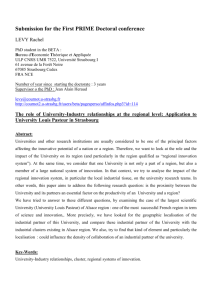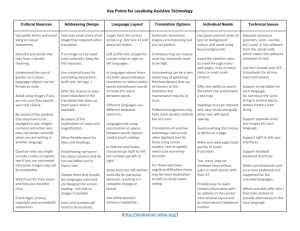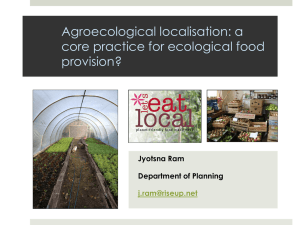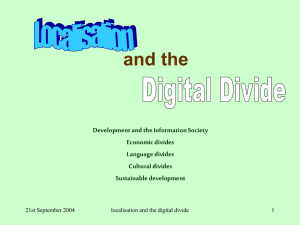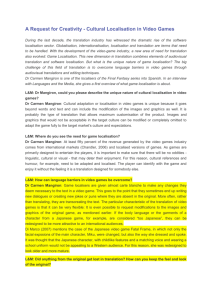Presentation
advertisement
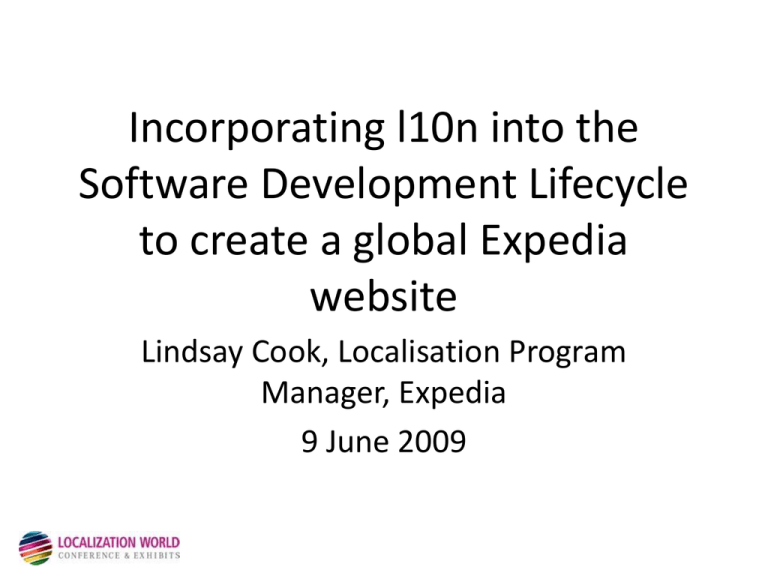
Incorporating l10n into the Software Development Lifecycle to create a global Expedia website Lindsay Cook, Localisation Program Manager, Expedia 9 June 2009 Today’s presentation • Show how Expedia incorporates l10n into the software development lifecycle in order to simultaneously ship enhancements globally • Context: – Who we are – How we are organised – How we work • Where localisation fits in • How we are able to simship enhancements globally • Challenges, pros and cons Expedia, Inc North America Specialty & Private Label Corporate International Context • Expedia is part of Expedia, Inc – 18 sites globally: • Europe: – .co.uk, .fr, it, .de, .nl, .es, .be, .ie, .dk, .se, .no, .at • APAC: – .com.au, .co.nz, .co.in, .co.jp • North America: – .com, .ca – Each site can be configured differently and features can be switched on and off • e.g. display of taxes and fees Context • Expedia technology team: – Large in house development team based in Seattle and London – Increasing use of external partners based in Hungary and China – Development team made up of Program Managers, Developers, Testers, Release and IT support – Organised into global groups with close business partnership – Largely split by front end v back end Context • Technology: – Multiple platforms/technologies • C++, Java, .NET, SQL Databases • Live site releases: – – – – 4 planned major releases per year 6-8 planned minor releases per year Multiple ad hoc deployments Simship features to all sites • Development methodologies: – Mix of waterfall and agile Expedia User Interface Localisation • Localisation Program Managers within development team – Expedia localisation experts – Consult, advise, support – Deep understanding of product, technology, release process as well as localisation – Liaise with central localisation team • Central localisation team in a separate organisation – Not part of the technology team – Localisation partner communication and management – Linguistic Quality • Multiple external localisation partners SDLC Requirements Specification and designs Development and test Pre-release signoffs • Localisation takes place throughout project development Requirements • Requirements are global • Identified and communicated early in the process – This means anything new/large/problematic is highlighted very early • Change management process in place for requirement changes later on in the process • Requirements form the basis for all subsequent phases Specifications and Designs • Specifications – Specifications written by Program Managers and reviewed by all stakeholders • Localisation is treated as a stakeholder – Opportunity to feedback potential “localisation issues” • Implementation of a feature can be changed if not suitable for localisation • Designs – User Interface designs provided by Customer Experience – Opportunity to feedback potential “localisation issues” • Design can be changed if not global Development • Developers expected to write global, internationalised and localisable code – I18n and l10n guidelines to be followed – Source files picked up and localised multiple times during development – If code is not “localisation friendly” it is not too late to fix it as development is not yet complete – Linguistic QA can take place during development and testing… Test • Localisation testing is incorporated into functional testing – Extensive use of pseudo-localisation before localisation takes place – Localised files available throughout testing phase – Test cases carried out across all sites – Risk based testing used to prioritise test cases – Internationalisation and localisation defects identified and resolved while there is still time to fix them Pre-release signoffs/milestones • Localisation specific milestones that need to be signed off before going live – At “Zero Defects” there should be no outstanding localisation defects – “Test complete” includes completion of testing on localised sites and linguistic QA Case study • Hotel travel guides – “Fast Twitch” pages designed to be attractive to Google, enhanced for Search Engine Optimisation (SEO) – 17 sites (not Japanese) • Japanese site is relatively new so not in scope at time of this project – Regular releases and updates – Simship all enhancements Case Study – Requirements • • • • 17 sites must be supported Pages must be localised Page URLs must be localised SEO specific text/terminology will be provided by SEO experts and must be easily changeable – Actual text provided by business owner in all languages • E.g. meta descriptions, SEO keywords Case Study – Specifications • Highlight all text on page that needs to be localised, e.g. The following string(s) require localization: <POS> > <product> > <product> Destinations in <selected region> • Show how variables interact with localisable strings • Show where SEO specific text will be shown and therefore not “localised” • Very helpful reference material for the translators Case Study – Designs • Designs take text expansion into account – Show wrapping, long strings etc • Multiple iterations offers opportunity for changes • Remove all “.com” specific messaging Case Study – Development • Regular pseudo-localisation from the start of development • Examples of i18n defects reported (by dev, test, PM, translators) during development: – Untagged and duplicate messages – Place names not being returned in local language • Villes près de London – Word order issues due to variables • 4 etoiles Hôtels à Londres • Fixes: – Tagging untagged messages – Ensuring local place names returned – Improved tagging of messages with large numbers of variables to improve translatability Case Study – Test • Test plan specifically calls out localisation testing: Localisation Testing Localisation testing will be performed as part of the feature functional testing. Localisation testing will likely attempt to mitigate the risks of: Layout issues caused by the translation process The potential for unexpected English text appearing on localised POS The potential for the localisation process to introduce functional errors to the sites The potential for NLS for a specific POS being incorrectly configured on our sites target language Layout issues caused by the translation process • Automated test cases check against live site to spot unexpected changes to localised messages Case Study – Test • Test coverage carried out and reported across all sites Case Study – localisation • Project spec delivered as reference material • Weekly handoffs to localisation partner over 2 months • 2 linguistic QA cycles • Localisation complete one week before development/test complete • Any defects with localisation impact triaged and reviewed near the end of the project • No major localisation defects outstanding at release The end product Why this approach works • Localisation is part of development – Localisation deeply embedded into development • Processes • People – Localisation not seen as a separate task that is carried out when development is complete • Localisation requirements identified up front – Ability to plan and influence Why this approach works • Localisation happens early and often – Defects and issues are found early and fixed • The right localisation partner – Key attributes are: • Flexibility, can-do attitude • Happy to work in an environment where files are rarely final • Well developed engineering practices • Automated processes to aid turnaround time Challenges • Complexity – Technology, platforms, releases are all complex – Finding where a message comes from in order to fix it takes time and knowledge – Hard for translators to understand the bigger Expedia picture • Geographic distribution – Time differences...West Coast US, China, Hungary, UK • Challenging release schedules – Difficult to fit everything in and maintain quality expectations (both functional and linguistic) Challenges • In house and external partners – Difficult to ensure education and good practices are shared throughout the organisation – High turnover means regular localisation education needed • Localisation PMs not all from localisation background – They need to be trained up from scratch Summary • Having localisation as part of development works • The Expedia software development lifecycle is very challenging but we are still able to simship enhancements to 18 Expedia sites on a regular basis Questions? • I’m sure you have loads of questions…
